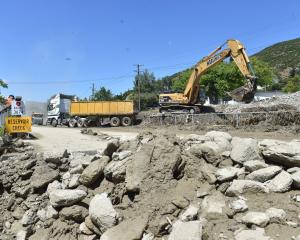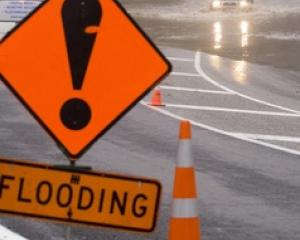Rain forecast for today and Thursday is not expected to significantly increase the water levels of Lakes Wakatipu and Wanaka, but wind-propelled wave action will continue to pose a risk to both Queenstown and Kingston for the next eight days.
"At 9am ... Lake Wakatipu has dropped 4.6cm below the highest level reached (311.480m above sea level) which was at around 10am [on Saturday]," ORC environmental engineering and natural hazards director Gavin Palmer said.
Lake Wanaka had dropped to 322mm below the first flood warning level.
Lake Te Anau was at 204.822m yesterday at 6.30pm, down from a peak of 204.92m on Saturday at 10am, the lake's highest level in 22 years.
Lake Manapouri's level peaked at 180.53m on Saturday by 10am - 1m less than its major flood in 1988 - and fell to 180.481m yesterday by 6.30pm.
Large quantities of ponding water remained on the foreshores of Queenstown Bay, Glenorchy and Kingston yesterday.
Businesses close to the resort's waterfront chose to begin restocking their premises from Saturday onwards as the flood risk appeared to be easing.
However, during a press conference on Saturday, Queenstown Lakes Mayor Clive Geddes said: "We're not out of this event completely yet. There are risks around it."
"ORC suggested for the lake to recede back down to 310.800m is likely to be around May 10 ... and I think we need to reinforce that between now and then, the lake will remain at a very high level and the risk of wave action driven by wind remains for that period and beyond it.
"We also need to remind ourselves that 310.800m is the trigger level we use to advise the community that a flooding event may occur," he said.
Upper Beach St, Rees St, Church St and Earl St reopened on Saturday afternoon, but Mr Geddes said the council preferred motorists did not use the route to see the flooded lakeside areas, so retailers could have ease of access.
Marine Pde and lower Beach St would remain closed until further notice.
Marine Pde would take some time to reopen due to the ponding effect behind the beach level, Mr Geddes said.
Costs to the community, via the council, centred on the wave mitigation work and came from half of the engineering services staff - eight people - being committed to the project for five days.
A cost assessment had started but real dollar figures were unavailable on Saturday.
However, Mr Geddes pointed out that 60,000 to 70,000 tonnes of sand had been used and that would have a cost.
District council staff began mapping which businesses were open or closed on Saturday to estimate how much revenue had been lost.
The Queenstown Chamber of Commerce would be consulted.
Mr Geddes said it was the business owners' call if they wanted to trade.
He said he was comfortable the councils had given them good data and many owners were monitoring websites, including the ORC's, and getting the same information both councils were.
"Walking along the edge of Rees St and seeing people restocking their shops and preparing to open for business, I think is a positive."
The mayor said he did not believe the flood had a negative impact on tourism.
He said he was surprised by the number of people observing the scenes at the waterfront on Friday.
It was business as usual for the rest of the resort, he said.
Queenstown harbour master Marty Black yesterday said boat owners should "keep all boats where they are, to be on the safe side, and check boats and kayaks on moorings".
An internal council debriefing involving emergency services was likely to be held at the end of this week.
A public session to advise business owners of the debriefing's findings would be held in association with the Chamber of Commerce in late May or early June.
The most positive thing Mr Geddes said he took from the episode was the way the business community had looked at the information, made their own decisions on flood protection measures in a timely way and were "wholly positive", despite the effect on their revenues.
"We have not had any bitching or complaining, in fact, quite the contrary, and I think we need to accept this type of flood event and those that are a little larger are, without a doubt, going to become a regular part of our lives in the years to come.
"They have been for the last 100 years and they will be in the future."




